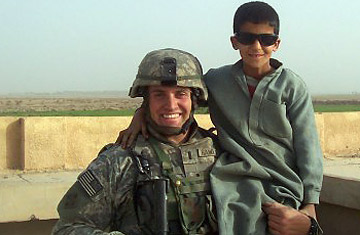
Then Lieutenant Nate Rawlings poses with an Iraqi child in February 2006
Part 1 of TIME's Return to Baghdad series.
An hour after landing at Baghdad International Airport, I found myself stuffed into the backseat of a blue station wagon, clenching my fists to keep my hands from shaking. The first time I drove this road was more than 4½ years ago in a Bradley fighting vehicle. The road, known to Americans as Route Irish, was one of the most dangerous places in Iraq. Units before us had dubbed it Purple Heart Boulevard; the Iraqis called it the Highway of Death, because even more civilians died there than American troops.
I usually commanded a gun-truck crew from the shotgun seat, laughing with my troops to ease our fears, sucking on cigarettes as I scanned the right shoulder of the road for anything that might explode. After two yearlong tours, 400 missions and countless humvee rides, I returned home with Baghdad's streets blazed into my memory.
One day after my first tour, I jumped into my trusty GMC Yukon. I was driving through Atlanta, screaming down a wide section of I-75, when an 18-wheeler blew a tire next to me. I felt my heart rate double and adrenaline shoot to my fingertips. I shouted to no one, "Contact, IED!," and looked around for my crew, only to discover that I was alone behind the wheel.
When I eased the car out of the traffic maelstrom, tears filled my eyes. I let out a scream and punched the steering wheel over and over, wondering what would have happened had anyone been riding with me. But the crippling fear was that this was how it was going to be. There would be no more road-trip vacations, no picking my kids up from school someday. I was a liability. If I couldn't function in a city I'd driven in a thousand times, there was no hope.
Then it struck me that I was still on the side of the road and had to go home. I held my breath as I picked my opening and gunned the car into the right lane. That day, a trip I routinely made in high school in under two hours took more than three as I puttered along, waiting for another explosion that never came.
A year after leaving the Army, I received an amazing offer: return to Baghdad with TIME's former bureau chief Bobby Ghosh, see the city through his eyes and experience the place as I never could in uniform. Even more amazing than the offer was the tour guide himself. As a young lieutenant patrolling neighborhoods in western Baghdad during some of the city's darkest days, I had read Ghosh's stories to see what was happening beyond my area and how we fitted into the bigger picture.
That was how I found myself in the backseat of the station wagon, on a road I had dreaded, hoping the other occupants couldn't see my anxiety. We drove under overpasses that were once riddled with bullet marks but now featured colorful murals. Traffic moved smoothly as it was a Friday, the Muslim holy day, and many people were at prayers. By the time the twin minarets of the Ibn Taymiyyah mosque came into view, marking the end of the highway, it felt like just another car ride.
Baghdad was where I went as a 24-year-old, tasked with playing a small part in trying to save the city from imploding. But for all the anguish I experienced and all the demons I took home with me, I never considered that for 8 million Iraqis, this was their home. The barometers of success now lie in whether the people of Iraq can live something close to the lives they wanted before the Americans arrived. Do they have dreams of a future for their children in this country, or has their imagination expired? Over the next week, we hope to find out.
